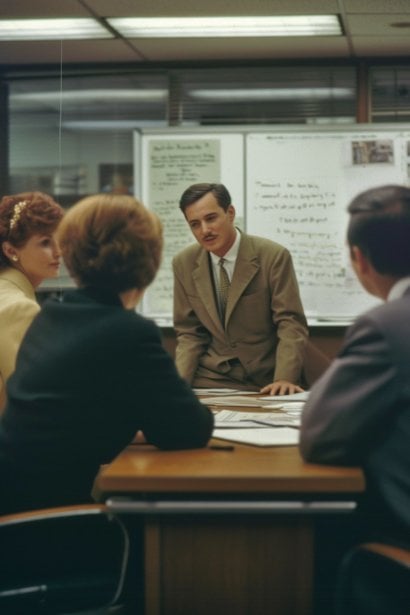What is a Fit Interview?

A fit interview is an essential phase in the job recruitment process where an employer assesses a candidate’s compatibility with the company’s culture and values. Unlike technical interviews that focus on skills and experience, the fit interview allows both the employer and the candidate to determine whether the candidate’s personality, motivations, and work style align with the organizational environment. Employers want to ensure that new hires will work well within their teams, contribute to a positive workplace dynamic, and uphold the company’s values over the long term.
During a fit interview, candidates might encounter questions that probe into their work ethic, communication style, problem-solving approach, and how they handle conflict or stress. It’s an opportunity for interviewers to understand a candidate’s intrinsic motivations and behavioral traits. Preparing for a fit interview typically involves reflecting on past experiences, understanding the company’s mission and values, and being ready to articulate how one’s personal values mesh with the company’s culture. A well-executed fit interview can be the deciding factor in the hiring process, as it provides a holistic view of the candidate beyond their resume.
Key Takeaways
- Fit interviews assess a candidate’s cultural and team compatibility.
- They involve questions on work ethic, communication, and problem-solving.
- Preparation includes reflecting on experiences and company values alignment.
Understanding Fit Interviews
Fit interviews are an integral part of the interview process, focusing on a candidate’s alignment with company culture and values. They assess personality, attitude, and soft skills beyond technical qualifications.

Defining the Fit Interview
A fit interview, also known as a cultural fit interview, evaluates whether a candidate’s values and behavior align with the company’s culture. Fit interviews are not about technical skills or experience; rather, they concentrate on understanding a candidate’s personality, values, and the likelihood of them thriving within the organizational environment.
Fit Versus Case Interviews
In consulting interviews, candidates often encounter two main types: the fit interview and the case interview. While case interviews are designed to assess analytical abilities and problem-solving skills through business scenarios, fit interviews examine the softer aspects such as values, interpersonal skills, and overall compatibility with the company’s culture.
Purpose of a Fit Interview
The purpose of a fit interview is twofold: to confirm that a candidate will enrich the company’s environment and to ensure the individual will find satisfaction and motivation in the workplace. Companies recognize that employees who resonate with the company culture and values are more likely to be productive, engaged, and retainable.
Key Components of Fit Interviews
The key components of a fit interview often include questions and discussions around:
- Values: What core values does the candidate hold, and how do they align with those of the company?
- Motivations: Why is the candidate interested in the company, and what drives their work ethic?
- Personality: How does the individual’s personality complement the existing team dynamics?
- Attitude: Does the candidate’s attitude towards work and collaboration fit with the company’s approach?
- Experience: Discussions of past experience may provide insight into the candidate’s behavior and adaptability within diverse team settings.
Preparing for the Interview
Successfully navigating a fit interview involves a strategic blend of understanding the prospective employer and presenting oneself effectively. Candidates should aim to align their qualifications and personality with the company’s culture and requirements.

Researching the Company
Knowing the employer is fundamental. Research should encompass not only the company’s history and products but also its culture, core values, and recent news within its industry. A thorough research strategy includes:
- Websites and publications: Read about the company’s milestones and news.
- Industry analysis: Understand the market dynamics and how the company fits in.
- Social media and blogs: Gauge the company’s brand voice and community engagement.
Self-Reflection
Self-assessment is critical. Reflect on personal experiences that showcase communication skills, teamwork, and leadership. Candidates should identify both strengths and weaknesses, considering how these can relate to the job role. Outlining experiences can assist in this by identifying:
- Soft skills developed over time.
- Experiences that required critical leadership skills or teamwork.
Developing Your Unique Value Proposition
It’s essential to articulate what makes one a prime candidate. This proposition should combine skills, experience, and values that align with the company. Create a precise statement that includes:
- Key skills and experience relevant to the role.
- How these attributes contribute uniquely to the employer’s success.
Understanding STAR Method
The STAR method structures responses to behavioral interview questions. This acronym stands for Situation, Task, Action, and Results. Understanding this helps candidates articulate their experiences effectively. Candidates should practice this method by detailing:
- Specific situations they have encountered.
- The tasks they were responsible for in these situations.
- Actions they took and the feedback or results generated.
Describing Your Ideal Work Environment
Interviewees should be able to describe what an ideal work environment looks like to them, reflecting on work-life balance and core values. This should be expressed in terms of:
- The type of work culture they thrive in.
- Ideal work schedule preferences that match the employer’s offerings.
Common Fit Interview Questions
Fit interview questions play a crucial role in assessing how well a candidate aligns with the company’s culture, values, and team dynamics. They provide insight into an individual’s past experiences and decision-making processes.

Cultural Fit Questions
Cultural fit questions are designed to determine if a candidate’s values and behaviors align with the company’s ethos. Common examples include:
- “How would you describe our company’s values based on your research?”
- “Can you talk about a time when you had to adapt to a company’s culture quickly?”
The interviewer is looking for evidence of the candidate’s understanding of company values and their ability to integrate into team dynamics.
Behavioral Questions
Behavioral interview questions focus on past behavior as an indicator of future performance. They often follow the STAR format (Situation, Task, Action, Result):
- “Describe a situation where you worked as part of a team to overcome a challenge.”
- “Give an example of a time when you showed initiative at work.”
Each question aims to elicit examples demonstrating how a candidate’s past behavior reflects their competencies and potential.
Situational Questions
Situational interview questions ask candidates to explain how they would handle hypothetical work scenarios, emphasizing problem-solving and conflict resolution skills:
- “How would you approach a situation where you have multiple conflicting deadlines?”
- “What steps would you take to resolve a conflict with a coworker?”
These questions assess a candidate’s ability to anticipate and navigate through potential work-related issues.
Experience-Based Questions
Experience-based questions require candidates to draw on their work experience and past projects to demonstrate their qualifications for the position:
- “Discuss a project that showcases your ability to lead a team.”
- “Explain how your experience has prepared you for the challenges of this role.”
The interviewer seeks concrete examples of a candidate’s skills, achievements, and learning experiences from their resume.
Evaluating Your Fit with the Team
When considering a candidate’s fit for a team, it is crucial to understand the existing team dynamics, management styles, and how the individual’s work style will mesh with the current structure.

Assessing Team Dynamics
Evaluating team dynamics is essential as it affects both day-to-day operations and overall team performance. Prospective employees should inquire about the team’s size, the nature of collaborative projects, and the level of interdependence among team members. It is important to understand if the team operates in a competitive or cooperative manner, as this can greatly influence an individual’s integration and success within the team.
- Size: Small or large team
- Collaboration: Frequency and types of projects
- Interdependence: Degree to which team members rely on each other
Identifying Leadership and Management Styles
Leadership and management styles can range from autocratic to democratic, and they play a significant role in how a team functions. Individuals should learn about their potential boss’s or manager’s approach to guiding and supporting the team. Understanding whether the management emphasizes innovation, strict adherence to protocols, or fosters an environment conducive to mentorship will help candidates envision their place and potential for growth within the team.
- Leadership Style: Autocratic, democratic, laissez-faire, etc.
- Management Style: Innovation-driven, protocol-oriented, mentorship-focused, etc.
Communicating Your Work Style
An individual’s work style is an integral part of how they will fit within a team. Candidates should clearly articulate their preferences for independence or guidance, their abilities as a team player, and their approach to problem-solving and conflict resolution. Effective communication skills are key to ensuring that an individual’s work style aligns with the team’s expectations and workflows.
- Independence vs. Guidance: Preference for autonomy or structured oversight
- Team Player: Contribution to teamwork and group dynamics
- Problem-Solving: Approach to challenges and obstacles
- Conflict Resolution: Strategies for addressing disagreements
Expressing Your Motivation and Values
In a fit interview, candidates have the opportunity to showcase their alignment with company culture through their motivations and values. The effectiveness of their communication in this area can leave a strong impression on interviewers.

Discussing Your Professional Goals
A candidate should articulate their professional goals with precision, explaining how they intersect with the company’s vision. For instance:
- Short-term goal: “She aims to leverage her expertise in digital marketing to increase brand visibility.”
- Long-term aspiration: “He envisions leading a team dedicated to innovative software solutions that align with the company’s mission for technological advancement.”
Explaining Your Core Values and Ethics
Candidates must convey their core values and ethics clearly, demonstrating how they mirror the ethical standards of the organization. They should discuss specific instances where their values guided their decisions. For example:
- Honesty: “Her commitment to transparency has been evident in her consistent communication with stakeholders.”
- Integrity: “He has a track record of making value-driven choices, even in challenging situations.”
Conveying Passion and Engagement
Passion and engagement are crucial for employers looking for candidates who will be enthusiastic contributors to their teams. Candidates should provide real examples that highlight their enthusiasm for their field. For example:
- Passion: “They consistently participate in professional workshops to stay ahead in industry trends, showcasing a deep passion for continuous learning.”
- Engagement: “She has a history of volunteering for company-wide initiatives, indicating a high level of engagement with her work and workplace.”
Handling Difficult Questions with Confidence
When faced with tough inquiries during a fit interview, candidates can demonstrate their competence by approaching each question with a structured response strategy, showcasing their problem-solving and communication skills.

Addressing Challenging Scenarios
Candidates should outline relevant experiences that demonstrate their resolution skills when discussing challenging scenarios. It’s beneficial to employ the STAR technique (Situation, Task, Action, Result) to structure responses:
- Situation: Briefly describe the context of the challenge.
- Task: Articulate the responsibility or goal in the scenario.
- Action: Highlight the specific actions taken to address the situation.
- Result: End with the outcome, emphasizing any positive impact or learned lessons.
Navigating Questions about Weaknesses
In discussing weaknesses, candidates are advised to be transparent yet strategic. They should:
- Acknowledge: A genuine acknowledgment of weak points shows self-awareness.
- Elaborate: Ideally, they choose a weakness that is not detrimental to the job role.
- Improve: Discuss concrete steps taken towards personal development and accepting constructive criticism.
This format helps interviewees transform a potential negative into a display of their commitment to growth.
Dealing with Ambiguity and Open-Ended Questions
Open-ended questions and ambiguous situations test critical thinking and adaptability. Respondents should:
- Pause: Taking a moment to think before speaking reflects poise.
- Clarify: If needed, they should ask questions to narrow down the scope of the inquiry.
- Respond: A structured response using clear, concise language displays their thought process and decision-making aptitude under potentially stressful situations.
By employing these strategies, individuals communicate their proficiency in conflict resolution and problem-solving, crucial for thriving in dynamic work environments.
Post-Interview Strategies
Once the interview has concluded, an individual’s approach to post-interview strategies is crucial in maintaining a professional image and can influence the decision-making process. These strategies are a direct extension of the interview experience, showcasing the interviewee’s communication skills and engagement with the potential employer.

Sending Thoughtful Follow-Up Messages
After a fit interview, candidates should send a follow-up message within 24 hours to express their gratitude for the opportunity. This message should:
- Thank candidates for their time and express appreciation for the meeting.
- Reaffirm interest in the position and the organization.
This communication can be in the form of a personalized email that mentions specific topics or discussions from the interview, which demonstrates attentiveness and interest. It’s advisable to keep the tone professional and the content concise.
Reflecting on the Interview Experience
Reflection is a key step for candidates post-interview to assess their own performance and note any areas for improvement. They should consider:
- What questions were asked and how well they responded.
- How their skills and experiences were conveyed and received.
Candidates may also contemplate any feedback provided during the interview and use it to gauge their standing in the process. While reflection is internal, candidates may reach out to the recruiter or hiring manager for constructive feedback if it was not provided, but this should be done respectfully and without pressing for immediate decisions. Engaging in this reflective practice not only aids in personal growth but also prepares candidates for future interviews.
Conclusion
A fit interview is a crucial step in the hiring process where candidates demonstrate their alignment with a company’s culture and values. Employers assess whether an individual will thrive within their organizational environment, beyond possessing the necessary skills and qualifications.
Key aspects of a fit interview include:
- Evaluation of personal traits and work style.
- Determination of a candidate’s potential for integration into the company culture.
- Insight into a candidate’s motivation and long-term goals.
Candidates should prepare by:
- Researching the company’s core values and culture.
- Reflecting on their own professional values and career aspirations.
- Practicing responses that convey their compatibility with the company.
An effective fit interview benefits both parties, helping candidates find an environment where they can excel while enabling employers to build cohesive and productive teams. It’s an opportunity for mutual evaluation, with the aim of fostering a successful and enduring professional relationship.






